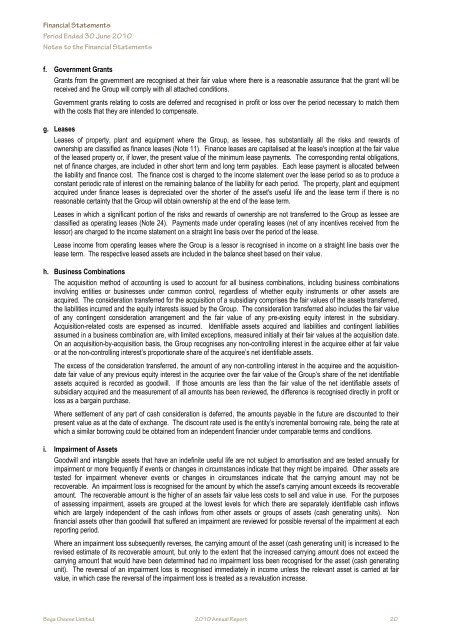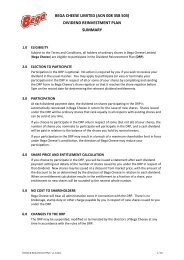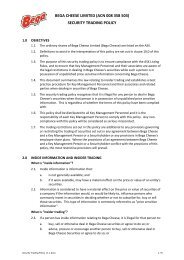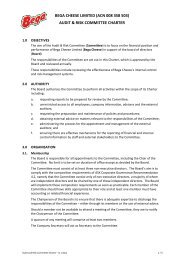Annual Report - Bega Cheese
Annual Report - Bega Cheese
Annual Report - Bega Cheese
You also want an ePaper? Increase the reach of your titles
YUMPU automatically turns print PDFs into web optimized ePapers that Google loves.
Financial Statements<br />
Period Financial Ended Statements 30 June 2010<br />
Notes Period to Ended the Financial 30 June Statements<br />
2010<br />
Notes to the Financial Statements<br />
f. Government Grants<br />
Grants from the government are recognised at their fair value where there is a reasonable assurance that the grant will be<br />
received and the Group will comply with all attached conditions.<br />
Government grants relating to costs are deferred and recognised in profit or loss over the period necessary to match them<br />
with the costs that they are intended to compensate.<br />
g. Leases<br />
Leases of property, plant and equipment where the Group, as lessee, has substantially all the risks and rewards of<br />
ownership are classified as finance leases (Note 11). Finance leases are capitalised at the lease's inception at the fair value<br />
of the leased property or, if lower, the present value of the minimum lease payments. The corresponding rental obligations,<br />
net of finance charges, are included in other short term and long term payables. Each lease payment is allocated between<br />
the liability and finance cost. The finance cost is charged to the income statement over the lease period so as to produce a<br />
constant periodic rate of interest on the remaining balance of the liability for each period. The property, plant and equipment<br />
acquired under finance leases is depreciated over the shorter of the asset's useful life and the lease term if there is no<br />
reasonable certainty that the Group will obtain ownership at the end of the lease term.<br />
Leases in which a significant portion of the risks and rewards of ownership are not transferred to the Group as lessee are<br />
classified as operating leases (Note 24). Payments made under operating leases (net of any incentives received from the<br />
lessor) are charged to the income statement on a straight line basis over the period of the lease.<br />
Lease income from operating leases where the Group is a lessor is recognised in income on a straight line basis over the<br />
lease term. The respective leased assets are included in the balance sheet based on their value.<br />
h. Business Combinations<br />
The acquisition method of accounting is used to account for all business combinations, including business combinations<br />
involving entities or businesses under common control, regardless of whether equity instruments or other assets are<br />
acquired. The consideration transferred for the acquisition of a subsidiary comprises the fair values of the assets transferred,<br />
the liabilities incurred and the equity interests issued by the Group. The consideration transferred also includes the fair value<br />
of any contingent consideration arrangement and the fair value of any pre-existing equity interest in the subsidiary.<br />
Acquisition-related costs are expensed as incurred. Identifiable assets acquired and liabilities and contingent liabilities<br />
assumed in a business combination are, with limited exceptions, measured initially at their fair values at the acquisition date.<br />
On an acquisition-by-acquisition basis, the Group recognises any non-controlling interest in the acquiree either at fair value<br />
or at the non-controlling interest’s proportionate share of the acquiree’s net identifiable assets.<br />
The excess of the consideration transferred, the amount of any non-controlling interest in the acquiree and the acquisitiondate<br />
fair value of any previous equity interest in the acquriee over the fair value of the Group’s share of the net identifiable<br />
assets acquired is recorded as goodwill. If those amounts are less than the fair value of the net identifiable assets of<br />
subsidiary acquired and the measurement of all amounts has been reviewed, the difference is recognised directly in profit or<br />
loss as a bargain purchase.<br />
Where settlement of any part of cash consideration is deferred, the amounts payable in the future are discounted to their<br />
present value as at the date of exchange. The discount rate used is the entity’s incremental borrowing rate, being the rate at<br />
which a similar borrowing could be obtained from an independent financier under comparable terms and conditions.<br />
i. Impairment of Assets<br />
Goodwill and intangible assets that have an indefinite useful life are not subject to amortisation and are tested annually for<br />
impairment or more frequently if events or changes in circumstances indicate that they might be impaired. Other assets are<br />
tested for impairment whenever events or changes in circumstances indicate that the carrying amount may not be<br />
recoverable. An impairment loss is recognised for the amount by which the asset's carrying amount exceeds its recoverable<br />
amount. The recoverable amount is the higher of an assets fair value less costs to sell and value in use. For the purposes<br />
of assessing impairment, assets are grouped at the lowest levels for which there are separately identifiable cash inflows<br />
which are largely independent of the cash inflows from other assets or groups of assets (cash generating units). Non<br />
financial assets other than goodwill that suffered an impairment are reviewed for possible reversal of the impairment at each<br />
reporting period.<br />
Where an impairment loss subsequently reverses, the carrying amount of the asset (cash generating unit) is increased to the<br />
revised estimate of its recoverable amount, but only to the extent that the increased carrying amount does not exceed the<br />
carrying amount that would have been determined had no impairment loss been recognised for the asset (cash generating<br />
unit). The reversal of an impairment loss is recognised immediately in income unless the relevant asset is carried at fair<br />
value, in which case the reversal of the impairment loss is treated as a revaluation increase.<br />
<strong>Bega</strong> <strong>Cheese</strong> Limited 2010 <strong>Annual</strong> <strong>Report</strong> 20<br />
<strong>Bega</strong> <strong>Cheese</strong> Limited 2010 <strong>Annual</strong> <strong>Report</strong> 20












